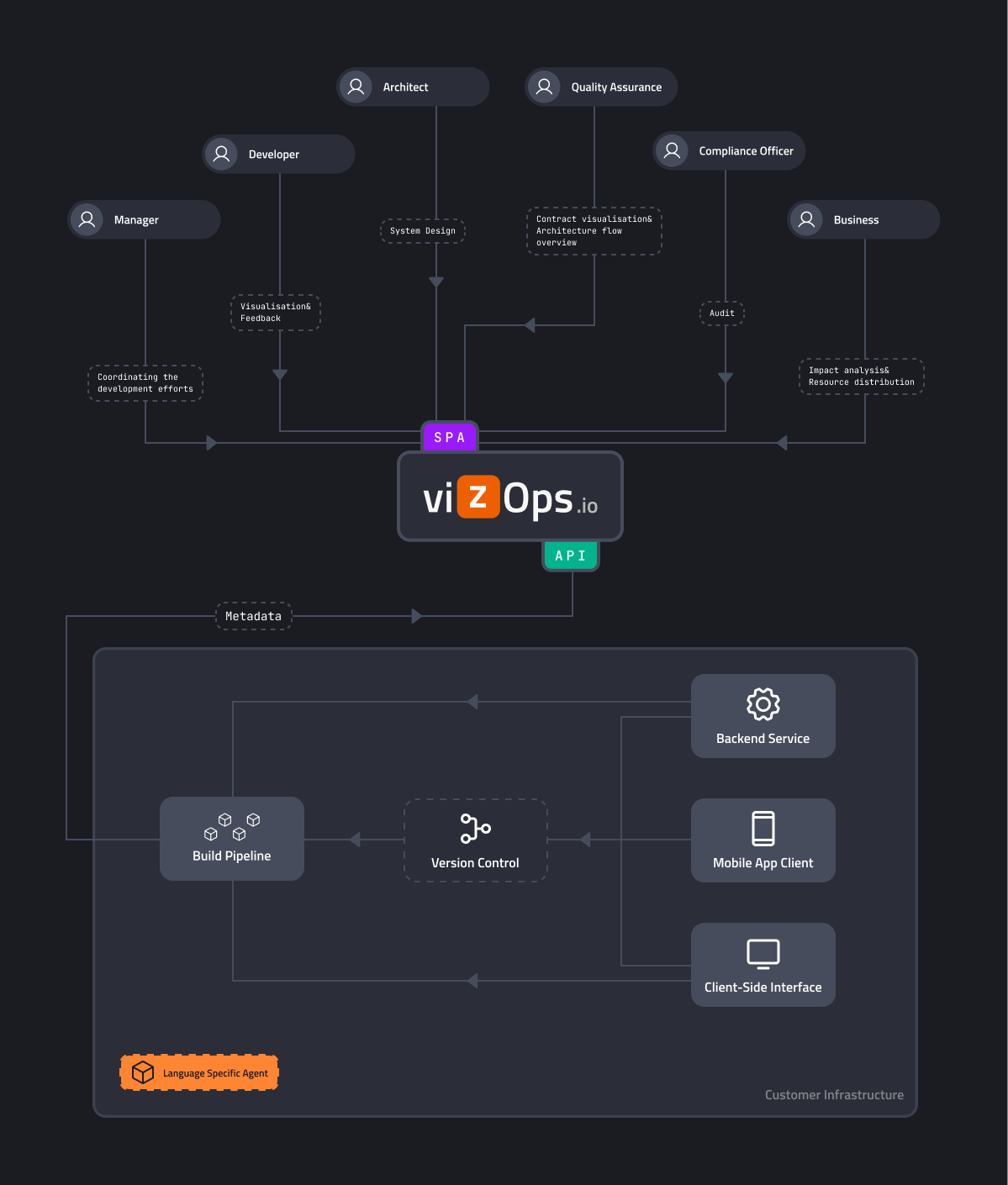Architecture Design
3.1 High-Level Architecture Diagram
To understand how vizOps operates within your development environment, it’s essential to grasp its high-level architecture. The system is composed of four primary components that interact seamlessly to provide real-time architectural insights.
Context Diagram

Component Overview
-
Language-Specific Agents
- Location: Developer’s machine or build server.
- Function: These agents integrate into the build process, performing code introspection to extract metadata about service dependencies, API contracts, and component relationships.
-
Centralized Metadata Service
- Location: Backend server.
- Function: Acts as the central repository, aggregating metadata from all agents, normalizing data, and maintaining a comprehensive system model.
-
User Interface (UI)
- Location: Web-based dashboard.
- Function: Provides an interactive platform for users to view and explore architectural diagrams, configure settings, and receive alerts.
-
CI/CD Integration Module
- Location: Integrated with your CI/CD pipeline (e.g., Jenkins, GitHub Actions).
- Function: Ensures that architecture validation occurs during the build process, automatically checking for issues like contract mismatches and reporting them back to the pipeline.
Component Relationships and Interactions
- Metadata Flow: Language-Specific Agents extract metadata and send it to the Centralized Metadata Service via secure communication protocols.
- Data Processing: The Centralized Metadata Service aggregates and processes the metadata, making it available to the UI.
- Visualization Rendering: The UI displays up-to-date architectural diagrams.
- CI/CD Feedback: The CI/CD Integration Module interacts with both the agents and the Metadata Service to validate builds and enforce architectural compliance.
3.2 Data Flow and Interaction
Understanding the data flow within vizOps is crucial for integrating it effectively into your development and deployment processes. Below is a step-by-step walkthrough of how data moves through the system.
Data Flow Description
-
Source Code Analysis by Agents
- During the build process, Language-Specific Agents parse the source code to extract metadata about service dependencies, API contracts, and component relationships.
- Output: Generated metadata files containing detailed architectural information.
-
Metadata Transmission
- The extracted metadata is securely transmitted to the Centralized Metadata Service using RESTful APIs or gRPC protocols.
- Security: Data is encrypted in transit to ensure confidentiality and integrity.
-
Metadata Aggregation and Processing
- The Centralized Metadata Service aggregates metadata from multiple agents, normalizes it, and constructs a comprehensive system model.
- Deduplication: Redundant data is identified and managed to maintain an accurate model.
-
User Interface
- The User Interface consumes the processed metadata to dynamically generate software diagrams.
- Interactivity: Diagrams support drill-downs and filtering to focus on specific services or interactions.
-
CI/CD Integration
- The CI/CD Integration Module queries the Metadata Service during each build to validate that no breaking changes have been introduced.
- Feedback Loop: If issues are found, they are reported back to the CI/CD pipeline, potentially failing the build or alerting the team.
Interaction Diagrams - WIP
[[Insert Sequence Diagram of Data Flow and Component Interaction here]]
Error Handling and Edge Cases
-
Contract Mismatches
- When a mismatch between expected and actual service contracts is detected, a warning is raised, and the impacted services are flagged within the UI for review.
-
Data Transmission Failures
- The system implements retry mechanisms and logs errors to handle temporary network issues during metadata transmission.
Security Considerations
-
Secure Communication
- All data transmitted between components is encrypted using TLS to protect sensitive information.
-
Role-Based Access Control (RBAC)
- Access to the User Interface and metadata is controlled through RBAC policies, ensuring that only authorized users can view or modify architectural data.
-
Data Storage
- The Centralized Metadata Service stores metadata securely, with options for on-premises deployment to meet compliance requirements that will be available in the future.
By providing this high-level architectural overview, detailed data flow descriptions, and a preliminary technology stack, we aim to offer a comprehensive understanding of how vizOps is designed to function within your development ecosystem. This foundation will guide the team as development progresses and ensure alignment with the overall vision of the project.